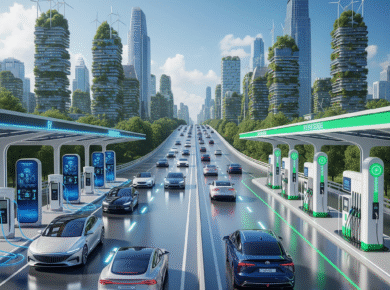Introduction
India is on the brink of a digital revolution. After successfully rolling out 5G across major cities, the country has now turned its focus to the future — 6G speed in India. With the launch of the Bharat 6G Mission, India aims to position itself as a global leader in next-generation wireless technology by 2030. The goal? To create ultra-fast, secure, and intelligent communication systems that can transform every sector of the economy.
In this blog, we’ll explore what 6G is, why it matters, how India is planning to lead this transformation, and the challenges it must overcome. Whether you’re a tech enthusiast, a policymaker, or someone curious about the next wave of internet innovation, this guide offers everything you need to know about India’s 6G development.
What is 6G?
6G, or sixth-generation wireless technology, is the successor to 5G and is expected to provide 100 times faster speeds, almost zero latency, and AI-integrated networks. While 5G introduced us to real-time video streaming and smart factories, 6G will push boundaries even further — enabling technologies like:
-
Holographic communication
-
Brain-computer interfaces
-
Autonomous vehicles with instant data relay
-
Massive-scale IoT with seamless connectivity
Predicted 6G Features:
| Feature | 5G | 6G |
|---|---|---|
| Max Speed | 10 Gbps | 1 Tbps (targeted) |
| Latency | 1 ms | <0.1 ms |
| Reliability | High | Ultra-high |
| Devices Supported | 1 million/km² | 10 million/km² |
This massive leap in capability underscores the potential of 6G speed in India and its global impact.
Bharat 6G Mission: India’s Roadmap to the Future
In March 2023, the Bharat 6G Mission was officially launched by Prime Minister Narendra Modi. The mission’s goal is simple but powerful — to put India at the forefront of 6G technology development and adoption by 2030.
Key Objectives of the Bharat 6G Mission:
-
Support R&D through funding, testbeds, and prototypes
-
Promote international collaboration with global 6G alliances
-
Empower startups and academia to drive innovation
-
Ensure inclusive rollout to bridge the digital divide
India is also one of the founding members of the International Telecommunication Union’s 6G Vision Group, indicating strong diplomatic and technical engagement on the world stage.
6G Speed in India: What to Expect
The projected 6G speed in India could range from 100 Gbps to 1 Tbps. That’s more than 100 times faster than today’s 5G networks. At this speed:
-
A 4K movie can be downloaded in less than one second
-
Remote surgery can be performed with real-time responsiveness
-
Smart traffic systems will react instantly to emergencies
With these advancements, the digital divide can finally be addressed, and rural areas can benefit from real-time education, e-health, and fintech.
Industry & Academic Participation
To build a thriving 6G ecosystem, India is banking on close collaboration between the private sector, startups, and academic institutions.
Examples of Key Contributors:
-
IIT Madras & IIT Hyderabad are developing 6G testbeds and prototypes
-
ISRO and DRDO are exploring space-based 6G infrastructure
-
Startups like Astrome & Saankhya Labs are working on mmWave tech
-
Major telecom players like Jio, Airtel, and BSNL are preparing for early trials
India’s government is also offering grants and fellowships to encourage innovation in areas such as terahertz spectrum, quantum communication, and AI-powered networking.
Key Benefits of 6G in India
Ultra-Fast Internet Everywhere
The 6G speed in India will make high-speed internet available even in the remotest villages. This will support:
-
Remote learning and digital classrooms
-
High-definition telemedicine consultations
-
E-governance with real-time citizen services
️ Smart Cities & IoT Expansion
6G will drive smart infrastructure by connecting:
-
Smart traffic and surveillance systems
-
Real-time water, waste, and electricity management
-
Connected vehicles and drones for logistics
AI-Driven Networks
6G networks will be self-optimizing, adapting to user needs in real-time. AI will manage bandwidth, data flow, and energy usage intelligently.
Economic Boost & New Jobs
India’s 6G push is expected to generate millions of new jobs in areas like:
-
Telecom hardware and software
-
Cybersecurity and AI engineering
-
Satellite communications and IoT analytics
If you’re looking for a future-proof career, 6G jobs in India are worth exploring.
Challenges India Must Overcome
Despite the exciting opportunities, there are several 6G infrastructure challenges that India must address:
️ Infrastructure Development
-
Telecom towers and fiber lines must be upgraded to support terahertz frequencies.
-
High-density urban areas and remote regions require separate infrastructure strategies.
Spectrum Allocation
-
Efficient use of new frequency bands like THz spectrum needs global coordination.
-
Auctions must ensure fair access without excessive costs to telecom operators.
Cybersecurity
With increased data flow and interconnected devices, 6G networks will be prime targets for cyber threats. Strong AI-based defense mechanisms and encrypted communication protocols are essential.
Global Standardization
India must actively shape international standards to ensure its needs are reflected and not just follow others’ designs.
Global Collaborations and Indian Diplomacy
India has already joined hands with countries like the US, Japan, South Korea, and Finland to collaborate on:
-
Joint research programs
-
Equipment interoperability trials
-
Policy dialogues on spectrum and governance
These collaborations will play a key role in realizing India’s 6G vision and ensuring it aligns with global expectations.
Future Use Cases of 6G in India
Here are some visionary use cases expected to be enabled by 6G speed in India:
1. Holographic Calls
Instead of video calls, imagine 3D holograms of people appearing in your living room. 6G can enable real-time holography.
2. Brain-Computer Interfaces
Devices that read your thoughts and perform actions — a potential reality with 6G.
3. Autonomous Vehicles & Drones
Self-driving cars and delivery drones will be safer and more efficient with ultra-low latency.
4. Smart Agriculture
Real-time monitoring of crops, soil health, and weather patterns to maximize yield and reduce waste.
5. Virtual Healthcare
Remote surgeries, diagnostic AI, and virtual health assistants powered by near-instant data transfer.
Indian Companies in 6G Development
Several Indian organizations are contributing to the 6G ecosystem:
-
Tata Consultancy Services (TCS) – Working on AI-driven network optimization.
-
Reliance Jio – Investing in indigenous 6G R&D and infrastructure.
-
Sterlite Technologies – Manufacturing high-speed fiber and wireless systems.
-
Tejas Networks – Developing 6G-compatible hardware and switches.
These players are crucial for building a self-reliant India in 6G technology.
Government Portals and Resources
If you’re interested in diving deeper, here are official resources to follow:
Conclusion: The Road to 2030 and Beyond
India’s ambitious journey into 6G isn’t just about speed. It’s about building an intelligent, secure, and inclusive digital future. From smart villages to holographic boardrooms, the possibilities are endless. The 6G speed in India could redefine education, healthcare, agriculture, logistics, and even how we interact with each other.
By investing in R&D, fostering international cooperation, and nurturing homegrown talent, India is not only preparing for 2030 — it’s shaping the global 6G narrative.
Final Thought
India is not playing catch-up anymore. It’s leading. The 6G speed in India will be the heartbeat of a digitally empowered nation — one that connects over a billion dreams in real-time.
Discover actionable tips and tech trends on ajexplains.com — the blog that makes complexity simple.







